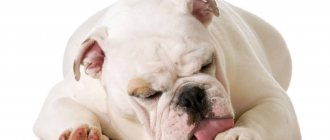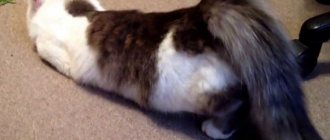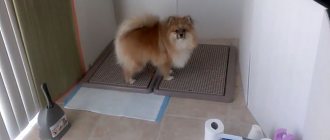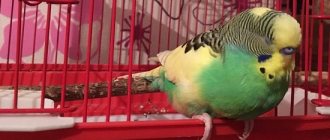Playful, inquisitive and active, Pomeranians are an excellent choice for beginners and experienced dog owners. They look great, have strong immunity and rarely get sick. But sometimes they have problems and health problems arise that need to be addressed immediately.
Each breed is predisposed to certain pathologies. The Pomeranian is no exception, diseases of which are often associated with the small size of the dogs, heredity, infections, parasites and poor quality care. Knowing the diseases typical for Pomeranians and their symptoms, the owner is able to provide assistance to the pet in a timely and correct manner.
Physiological abnormalities
The Pomeranian rarely gets sick and is able to remain active and cheerful into old age.
This health problem may arise due to: the breed's characteristic small size; anatomical warehouse; genetic abnormalities; improper care.
Typical problems:
Take the Attention Test! Find 10 differences! (click right here!)
Find the answer Are you bothered by some problem or question? Enter “Breed” or “Name of the problem” into the form, press Enter and you will find out everything about the issue that interests you.
- Weak musculoskeletal system;
- Dental pathology;
- Eye diseases;
- The peculiar structure of the larynx;
- Genetic diseases.
The breed is distinguished by a weak skeletal system. Joints are susceptible to dislocation and deformation. Fragile bones and ligaments sometimes cannot withstand movement. If a Spitz is obese, then problems with the musculoskeletal system cannot be avoided. Excess weight puts extra strain on your dog when he runs or jumps.
This joint problem will be expressed through movement. The dog may limp, jump when running, or move its front paws incorrectly. The pet will begin to get tired quickly and refuse to run.
You can reduce the risk of these problems with a balanced diet. The Spitz needs vitamins and minerals to strengthen bones and muscles. If the puppy is not strong enough, do not allow him to jump high or walk up the stairs. Monitor your pet's weight.
Dwarfism of the breed appears as a pathological manifestation of miniatureness. Mini Spitz dogs have impaired pituitary gland function. These are weak creatures with bulging eyes, an unformed fontanelle, and a problematic nervous system.
Dental disease often occurs due to the structure of the jaw. It may be difficult to change teeth. Sometimes baby teeth do not fall out on their own. This is the first cause of abnormal growth of molars. Owners often have to remove their pet's baby teeth at veterinary clinics.
Oranges often develop tartar and periodontal disease. This may be due to the shape of the jaw and improper care.
Spitz eyes are prone to severe tearing. Due to the short muzzle, the eyeball protrudes greatly. The animal's eyes are vulnerable to external irritants. Your pet's eyes should be examined regularly and wiped with special solutions.
The larynx of Pomeranians has a special structure. Unclosed cartilage plates cause coughing. Against the background of an infection, the trachea softens and collapses. Coughing attacks occur during rapid breathing and when the animal is restless.
Congenital diseases include:
- Hip dysplasia;
- Retinal atrophy;
- Disease of the thyroid gland and adrenal glands;
- Epilepsy.
Congenital pathologies cannot be prevented; their symptoms can be alleviated.
History of the breed
The history of the breed began in the lands of northern Europe , where the ancestors of the Pomeranians lived, who were much larger than their modern relatives. Peat dogs , as the ancestors were called, due to their strong physique, were used for riding , in which they showed endurance and strength.
Then interest in these animals was shown in Germany , and it was there that Spitzhunds , which became widespread by the end of the eighteenth century. The Prussian province of Pomerania is rightfully considered the homeland of the German Dwarf Spitz , but the individuals bred there were much larger than their modern relatives and weighed more than fourteen kilograms .
Great Britain plays a significant role in selection . In Florence, Queen Victoria met a Pomeranian who delighted her with his appearance and became her favorite. The dog Marco , that was the name of the dog, went with the queen to England , where he took part in various exhibitions and shows.
Looking at the royal pet, nobles and local residents wanted to purchase representatives of this breed. And so, by the end of the nineteenth century, kennels appeared , and the Pomeranian Spitz was awarded a separate dog breeders club.
Thanks to English breeders, the breed not only acquired a more attractive appearance, but also its weight became significantly less . All Spitz were divided into individuals weighing up to three kilograms and those weighing more than three. The size of the Pomeranian became an ideal for breeders from other countries who sought to develop a miniature breed.
On the eve of the 20th century, the breed was brought to America , where it gained the love of the inhabitants. However, it was not until the beginning of the next century that the Pomeranian was recognized by the American Kennel Club. The Americans continued to work on the breed with the goal of breeding a smaller individual, but miniature dogs had problems with childbearing , and therefore the breeders abandoned this idea.
In Russia, the Pomeranian is extremely popular, although it has not yet been identified as a separate breed by the Russian Canine Federation , but is considered one of the varieties of the German Spitz.
Other difficulties encountered
Dogs often suffer due to owner irresponsibility.
An animal without timely vaccination can contract enteritis, distemper, and viral hepatitis.
Neglect of preventive measures leads to infection with parasites and related diseases.
A number of problems are caused by poor nutrition. Poor quality food can cause diarrhea or constipation. Possible food allergies, which will affect the condition of the skin. The dog develops skin itching and dandruff. You cannot overfeed your pet and spoil it with food from the table. The quality of feed affects the functioning of the liver, kidneys, and gastrointestinal tract.
Don't turn your Spitz into a lap dog. He benefits from moderate physical activity. Otherwise, your pet will have weak muscles and fragile joints. Infrequent exposure to fresh air reduces immunity. A sedentary dog is susceptible to gaining excess weight.
Follow hygiene procedures. Take care of your pet's mouth, eyes, ears, and fur.
When signs of illness appear, it is important to start treatment on time.
Care
An excellent quality is the ease of caring for oranges.
Despite his fluffy long coat, there is no need to wash your dog frequently.
But you need to comb it regularly.
However, this is also a positive point, because with constant combing, you won’t have to frequently clean the entire apartment of hair.
Diseases and signs that definitely show that not everything is okay
When a dog is sick, he is ready to convey this to his owner in different ways, except that he cannot speak, so you should be attentive and listen to the signals sent by your pet. it's time to sound the alarm.
There are many diseases, each with different consequences. It is important to identify it and reduce the harm. The disease can be identified by the first symptoms that appear.
There is no need to set yourself up for negative thoughts if suddenly the dog seems lethargic to you. Think about it, even you have this condition from time to time. If you know that your dog loves to chew everything he finds on the street, then be prepared for frequent stomach upsets, which you don’t need to worry about.
If something worries you, it is better to double-check your pet’s health status. Symptoms will be varied, even unpredictable.
There are 3 main ones that you should pay attention to first:
- Fever;
- Apathy, lethargy;
- Refusal of food.
Every veterinarian should learn about dog diseases, their signs and treatment. Symptoms will become harbingers of both the mildest and fatal diseases. There is no need to draw any hasty conclusions and, especially, treat your pet yourself. Only a veterinarian can establish an accurate diagnosis and prescribe the correct effective treatment.
What is the price
For a good purebred German Spitz puppy, prices start from 30,000 rubles. But this does not mean that the puppy that costs less is defective or sick. Breeders may reduce prices for various reasons:
- Emergency trip
- the puppy begins to molt and loses its presentation
- large number of puppies for sale
- After all, I urgently need money
Pomeranians are some of the cutest creatures in the world, and you can see this for yourself by watching the video.
Pomeranian Spitz puppy Benjamin:
Digestive system diseases
Quite common, varied in variety and associated with feeding errors. If a dog is overfed, obesity may occur, especially spayed and neutered animals. The first sign is excessive excess weight, which is bad for the heart. As a treatment, use a reduction in diet and exclusion of fatty foods.
A perverted appetite (a dog eating feces, stones, earth) can be a sign of serious diseases of the internal organs.
Errors in nutrition can also cause gastritis, which can be identified by symptoms: vomiting, weight loss, dull hair, and dandruff. If at least 2-3 signs are present, you should contact a veterinary clinic for treatment, since advanced forms can be fatal.
At home, it is enough to diagnose constipation - if the dog has problems with bowel movements: he whines, spins in one place, strains, but cannot recover. Constipation without proper attention can lead to serious consequences, since undigested food accumulates in the intestines and leads to rupture. If the animal's skin has acquired an unpleasant yellow tint, this may be a signal of liver disease; only a doctor can treat them.
Photo gallery
Take the above seriously, follow all precautions, do not neglect the advice of experienced specialists, and then all illnesses will bypass your dog.
Surgical deviations
These include:
- Injuries;
- Muscle diseases;
- Dental diseases;
- Ear diseases;
- Eye diseases.
Observation of the animal will allow you to determine the likelihood of any of them. If the eyelids are red and swollen, there is purulent discharge from the eye, and the dog is photophobic, this could be a sign of conjunctivitis. For treatment, the eyes are washed with a 2% solution of boric acid.
If, along with these signs, a thorn has formed on the dog’s eye, it may be keratitis (inflammation of the cornea). Ear diseases are widespread. If a hot and soft swelling is detected in the auricle during an external examination, this may be a sign of injury. The following signs will help you recognize otitis: the dog constantly tilts its head to the side, tries to scratch its ears, and reacts painfully when trying to touch them.
For treatment, the auricle should be thoroughly cleaned using a cotton swab and hydrogen peroxide. There are many diseases that dogs are susceptible to, each of them has its own set of symptoms, allowing veterinarians to make the correct diagnosis.
The first symptoms of any disease are changes in the dog’s behavior: it becomes lethargic and apathetic, or, on the contrary, excessively violent and active; he loses or, on the contrary, develops a strong appetite. Many diseases are signaled by changes in body temperature, heart rate, and copious salivation. If you notice several symptoms at once, you should not self-medicate; you should contact a professional as soon as possible.
Anal glands
If you witness a Spitz “riding” on its butt on the carpet or floor, dragging its hind limbs, do not rush to be moved. In the best case, he still has residues of vital activity on his fur, and he is trying to get rid of them in this way. If the fur around the anus is clear, the problem is most likely in the anal glands. The contents of the anal sacs have the ability to accumulate and cause discomfort.
Experienced breeders independently control the situation and empty the resulting stagnation in a timely manner. To do this you need:
- place the Spitz on a flat surface;
- hold the tail with one hand and feel the anal sacs with the other;
- making pressing movements, move inward and upward, moving towards the anus;
- Be careful not to get the contents on you.
Bowel problems usually worsen with age. Activity decreases, metabolism slows down, and intestinal contents begin to thicken and accumulate. Monitor the dog’s condition and behavior; as a rule, any ailments primarily affect the Spitz’s mood.
Prepare before going to the vet
In the office, you may have to provide the veterinarian with all possible assistance (hold the animal while they take blood for analysis, give an injection, extinguish aggression, calm your voice, scratch its ears, stroke it). If you know that you are terrified of blood, IVs, or definitely cannot withstand the type of medical interventions, then perhaps you should ask a friend or relative for help.
Find a veterinary certificate, veterinary passport.
Take:
- Leash;
- Collar;
- Muzzle;
- Carrying;
- A pack of napkins;
- litter;
- Bowl, water (at the veterinarian's discretion)
Prepare answers to possible questions from the veterinarian:
- Are all vaccinations up to date on the animal?
- Pet’s behavior in recent days, appetite;
- His diet;
- What drugs and medicines did you give to the animal;
- Latest test data (if available).
It’s better to make an appointment in advance - you’ll save time and be able to calculate when you’ll have to take time off. This does not apply to life-threatening situations where you will have to take an animal to a veterinary clinic without an appointment.
Be affectionate with your pet, play, talk to him. You can take his favorite toy with you so that while you wait for your turn at the reception, you can distract your friend from the new environment.
Furry, feathered or scaly ones also need to be prepared. No matter how much you want to treat your little one with something tasty, remember: you need an empty stomach. Feeding is prohibited!
You can wash your animal without using detergents. But it is important not to touch your pet if there is nasal discharge, watery eyes, salivation (salivation), dandruff, scratching, rashes, skin scabs, loss of hair/feathers/scales, wounds and other external manifestations of a potential disease.
If the veterinarian has instructed, collect the animal’s urine in a sterile container, and pick up the feces with a stick (no blades of grass, specks, or debris). Transfer the feces into a sterile container. Send to the biochemical laboratory within 6 hours. The feces are examined for eggs of roundworms, pinworms, tapeworms, liver flukes, echinoccus, alvecoccus, pork tapeworm, bovine tapeworm, and gastrointestinal bleeding is detected.
At the veterinary hospital, the animal’s blood will be analyzed for antibodies to allergens, viruses, bacteria, and parasites.
Choosing a veterinary clinic
We determine the veterinary clinic where you plan to go. A big PR company doesn't promise quality. The price is explained by the huge amount of money invested in advertising and “signboarding” of the establishment.
It’s great if you can ask your friends about clinics where their pets were treated “humanely.” If you travel far from them, it may be worth sacrificing time for the health of your pet.
A few more tips on how to spot an unverified veterinary clinic:
- Refusal to provide certificates and licenses for veterinary activities.
- Strange and suspicious behavior of the veterinarian (inconsistency, flattery, attempts to intimidate, shouting).
- Prices are too low (compared to other organizations).
- Refusal to freely visit the veterinary clinic.
“We have a sanitary day”
Beware of scammers!
When you contact the veterinary clinic, you are informed: “we cannot accept you at this address, sanitary day/repair/inspection.” How much intelligence does a dispatcher have? The client is persuaded to have a veterinarian come to his home. The price does not change.
A veterinary clinic can exist purely nominally. And the invited “Aibolit” will not bear responsibility. There is a high probability of running into a person without a veterinary diploma or simply an unprofessional.
It is better to find time to visit the veterinary clinic on your own. This is safer for the animal.
Character, behavior
Despite their pretty appearance with a constant “smile” on their face, Spitz dogs have a wayward character.
They are a classic example of dominant dogs.
That is why the dog needs to be shown from early childhood that the owner is more important. Then the Spitz will behave very calmly and docilely.
You need to be careful when owning a Pomeranian with other pets. If a dog communicates with other pets since childhood, then they will be best friends even with a cat. However, an adult dog, accustomed to living only with its owners, will not be at all happy with the new animal.
With all the good nature of Spitz dogs, it is necessary to teach small children how to behave around a dog. Spitz never forgives an insult. If a child hurts a dog, he will behave quite aggressively towards the child.
If the owners take care of the dog from a young age, it will not cause discomfort to anyone. The Pomeranian will not just bark or attack people.
If the owner understands that it is difficult for him to raise a dog alone, he needs to seek help from a professional dog handler.
Games on feelings
In real veterinary clinics there will be elements of “divorce”.
Veterinarians say that this is often determined by the client’s wallet. The greater the opportunity to pay for services and the more the owner worries about his pet, the more likely the animal will be prescribed additional immunostimulants, dietary supplements, water-soluble and fat-soluble vitamins, and special food. There are cases when this is really necessary (pedigreed, show animals, weakened after a serious illness). But it will be good if you ask your veterinarian in detail about the need for each appointment. Find out in detail about the results of the examination and analysis of your pet’s condition. Be persistent. Do not give in to attempts to intimidate you, be consistent in your questions. Consult a specialist who does not work at this veterinary clinic. If it turns out that half of the prescriptions are prescribed to enrich the veterinarian’s pocket, and not for the health of the animal, feel free to leave. And do not forget to leave a negative review about the organization - other owners may also suffer.
Description of the breed
Pomeranians have characteristic features that set them apart from other species. This is a small dog with a small neat muzzle, reminiscent of a fox, small button eyes and a somewhat elongated nose.
Standards
The main proportions of a Toy Spitz are the ratio of body length to height from the withers to the floor 1 to 1, the ratio of the skull to the muzzle 4 to 2.
Head
- There is a wedge-shaped narrowing of the head towards the nose.
- Small black or dark brown nose.
- Black lips close to the jaw, without folds.
- Scissor bite or straight bite.
- The eyes are dark, almond-shaped, and set slightly askew.
- The ears are pointed, small with a hard tip, close to each other.
Torso
- The back is straight and short.
- The croup is not sloping.
- The chest is deep.
- The stomach is tucked.
- The tail fits tightly to the back, curled upward from the base.
Limbs
- The shoulder blades form a right angle with the shoulder.
- The front legs are round and short, the toes are compressed.
- The hind limbs stand parallel.
- The pads are hard and dark.
Wool
The Pomeranian has a short, dense undercoat and long, straight hair . The head, ears and front sides of the limbs are covered with short, smooth hair. A thick mane adorns the shoulders and neck .
Colors
There are different types of colors, with a total of about sixteen . The final color of the four-legged coat appears after molting, at six months. They also reach their maximum size at this age.
Red dwarf Spitz have become the most popular and widespread , although there are also cream, brown, black, white, and two-colored individuals. The white Spitz was one of the last to appear, since it is difficult to breed a breed of pure color without impurities . The same applies to black color. It is necessary to take into account the color of the dogs and their ancestors so that there are no unexpected impurities in the litter.
White : The coat is perfectly white, with a possible hint of yellow on the ears.
Black : The coat is pure black. The undercoat is dark to match the skin color.
Brown : The coat is evenly colored, dark brown.
Orange : The coat is uniformly colored, with lighter shades possible on the tail and chest.
Wolf Grey : Silvery gray with black tips. The muzzle and ears are dark, with a graphic pattern around the eyes.
Spotted : Solid colored spots are placed on a white background.
Character
Smart, playful, friendly and sensitive dogs, wonderful companions and loyal friends . They love children, but you should not leave them with babies, they can accidentally harm the dog. Despite its small size, an adult pet considers itself a big dog and often fights with animals that are much larger in size.
Speaking about the Pomeranian, it should be noted that by nature they tend to dominate . Dogs of this type consider themselves masters of the house and will not tolerate a stranger , even if he is much larger and stronger. It is important to cultivate the pet’s character, not to spoil them; they sense the slightest mood swings of the owner and react to reproaches or praise. very attached to their owner and are ready to protect them at the slightest danger.
There are also disadvantages in the characteristics of the breed, the main ones being the loud and sonorous constant barking , it quickly tires and even irritates, especially strangers who are not accustomed to this. Education and regular training will help to cope with this feature.
How to find out the truth
Another possible way for veterinarians to make dishonest money is to conceal the diagnosis. Let's say a veterinarian discovers a malignant tumor in a cat. But if he says that the tumor is benign and treatable. A housewife who dotes on her pet will give money for already useless procedures, medications and surgical interventions.
The veterinarian may deliberately “downplay” the diagnosis in order to earn more money. If something doesn't add up, insist on clarification. There is no need to be intimidated by unfamiliar terms - take a short break and try to find information on the Internet.
You are free to leave (or threaten to do so) to another clinic at any time.
Make sure that the veterinary clinic is honest - get tested in an independent laboratory.
Justice
What to do if an animal was injured as a result of unprofessional actions of a veterinarian:
- Write an official complaint addressed to the head of the clinic.
- File a complaint with the city veterinary department.
- You can contact Rospotrebnadzor.
- Contact a lawyer for help
The Law “On the Protection of Consumer Rights” and Article 245 of the Criminal Code “Cruelty to Animals” are the grounds for considering claims regarding the work of veterinary clinics.
Fontana problems in Pomeranians
Everyone knows that the fontanel is located on the top of the head. It is also present in newborn puppies. Why do Pomeranians have fontanelle problems? For example, in large dogs they close up a couple of months after birth, but in miniature breeds the “hole” often remains for a long time.
If you are not sure whether your pet’s fontanelle has healed, contact a specialist.
The fontanel itself does not pose any danger. Between the brain and the skin there is quite strong connective tissue that protects the important organ. The fact is that difficulties with the fontanelle appear only in dogs that are bred for exhibitions.
How to find a fontanel? You need to place your finger on the top of the skull. When it is present, you can feel the pulsation and warmth under your hands. If you gently move your finger around the area, you can find the specific extent of the missing bone. If you are not sure whether your pet's fontanelle is healing, consult a specialist. To help the fontanelle heal, it is necessary to give the puppy calcium. Be sure to consult your veterinarian regarding dosage.
Saving
What to do if funds are limited and your pet needs medical care:
- Some procedures can be carried out independently. Giving a drug injection to a cat or dog is not difficult. Dressing uncomplicated wounds is also sufficient. Ask your veterinarian to teach you.
- How to properly give a pill to an animal: hide it in a lump of tightly rolled minced meat. If the animal bites through the decoy, you can crush the tablet and dissolve it in water, milk, liquid porridge, or food.
- If an animal has been prescribed a course of vitamins or some other non-medicinal but expensive drugs, it may be worth finding analogues at a lower price.
- There are various benefit programs in which you can participate. This could be, for example, sterilization, castration, or vaccination of an animal.
Important points
- Refusal to vaccinate. This is dangerous for the animal and all those who will come into contact with it (people). Vaccination is a scientifically proven method of preventing many infectious diseases. Get your animal vaccinated by a trusted veterinarian (or with his approval yourself). It is important to get vaccinated against rabies - this is a fatal disease induced by the Rabies lyssavirus virus, which cannot be cured, but can be prevented.
- Anesthesia - inhalation, intravenous, anesthesia - epidural, conduction. They are necessary so that the animal does not suffer, to prevent painful shock. The veterinarian’s “hands on” are important here - both overdose and weak anesthesia lead to serious consequences (shock, poisoning, death) for the animal.
- Sterility, antiseptic. If you see that the veterinarian does not follow the rules of antiseptics (reuses disposable syringes, diapers, bandages, does not treat hands with antiseptic after contact with the previous animal), the best choice would be to contact another veterinarian.
- Important medicines:
- Antibiotics - amoxicillin, tilozil, trimethoprim, sulfadiazine, lincomycin, marbofloxacin;
- Antipyretics - paracetamol, salicylic acid preparations, antipyrine, butadione, amidopyrine;
- Anti-inflammatory drugs - vedaprofen, choline salicylate cycloferon, aspirin;
- Anesthetics - novocaine, lidocaine, dicaine, trimecaine;
- Hemostatics - fibrinogen, thrombin, vikasol, phytomenadione, calcium chloride, etamsylate;
- Antiparasitic - praziquantel, aversectin, albendazole, ivermectin, fluralaner.
If you care what happens to your pet, you should not neglect appointments.
Don't let unverified veterinary clinics endanger your pet and profit from their owner's feelings! If you have time and desire, it is worth trying to achieve justice in case of violation of ethical or legal standards.
Spitz haircut
The only acceptable option for cutting a Spitz is the so-called show grooming. That is, lightly trim the guard hair to give the coat a circle shape without affecting the undercoat. Many owners think that the Pomeranian is hot in the summer and needs to be cut. This is absolutely not true.
- If you remove the guard hair, the undercoat will mat into cotton wool and will not allow air to pass through.
- The dog's coat creates an air layer and protects the skin from overheating and direct sunlight
- To improve ventilation, comb the undercoat well.
- Cooling down of a dog occurs through rapid breathing
- After swimming in the sea, be sure to wash your dog
Along with a haircut, a Spitz gets a mountain of problems:
- Lack of cooling in hot weather can lead to heatstroke and sunstroke
- Felted and unventilated wool
- Decreased immunity and, as a consequence, skin diseases
- Alopecia
- The fur will not grow back evenly, and in some places it may even become completely bald. So you can say goodbye to the beauty of the dog forever











